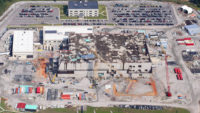The full cost to build the much delayed Mixed-Oxide Fuel Fabrication Facility (MOX) project at the Savannah River site in South Carolina eventually could triple its original estimate, the Dept. of Energy acknowledged in a Jan. 15 project-management report. "Estimates for the capital work range from $8 billion [to] $12 billion, depending on the funding profiles," stated DOE's report. The agency also said capital expenditures so far have totaled $4 billion—the contract's original cost estimate—with construction only 50% complete, more than seven years after work first began.
Project critics used DOE's report to renew calls to halt the "MOX boondoggle," as one watchdog called it, and argued for reconsideration of other alternatives.
"Let's hope that this report is an indication that dramatic steps are being taken," stated Tom Clements of watchdog SRS Watch.
"It's time to pursue cheaper, safer alternatives," added Edwin Lyman, a scientist with the Union of Concerned Scientists (UCS). In a press statement addressing the DOE report, Lyman said the plan to convert weapons-grade plutonium into MOX fuel makes it easier "for terrorists to steal plutonium during processing, transport or storage."
Lyman and UCS also argued that options exist for disposing of the 34 metric tons of material covered by a 2000 agreement between the U.S. and Russia. For example, "downblending" dilutes plutonium with non-radioactive material.
Last year, Congress directed the National Nuclear Security Administration to conduct "an independently verified life-cycle cost estimate"—due out this spring—for completing the MOX facility and downblending.
A 2014 Congressional Research Service report, citing the World Nuclear Association, states that Russia is gearing up to use a reactor at its Beloyarsk plant to burn as much as 1.7 million metric tons of weapons-grade plutonium per year.






